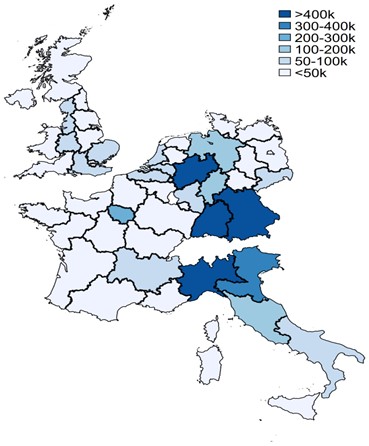
How enduring high energy prices could affect jobs
5 May 2025
By Gert Bijnens, John Hutchinson and Arthur Saint Guilhem
Lasting high energy prices are putting pressure on industries all across Europe. This is hitting some regions, such as southern Germany, the Ruhr and northern Italy, harder than others. The ECB Blog examines the implications for employment.
High energy costs threaten the competitiveness of European firms and weigh on employment. Based on firm-level data, we estimate that a permanent rise of 10% in electricity prices could reduce employment in energy-intensive sectors by up to 2%. And the damage could be even bigger: for every job lost in high-tech manufacturing, several more may follow in local services.[1] These effects are even more significant in areas with clusters of energy-intensive industries, including southern Germany, the Ruhr, northern Italy and, albeit to a lesser extent, northern Belgium. Cheaper and cleaner energy, policies to retrain workers and labour market flexibility could help address the challenges.
Persistently elevated energy prices: a chronic challenge for the euro area
Despite falling from their 2022 peaks, euro area energy prices are still well above the long-term averages and might well stay elevated for the foreseeable future. High prices are a financial strain for households and companies alike. This is especially true for electricity, which represents a sizeable and increasing share of energy consumption in the euro area. While prices for households are driven to a large extent by distribution charges, taxes and regulations, large industrial users are directly exposed to wholesale market trends. Here, prices – which once stood at around €75/MWh – now exceed €100/MWh and have even topped €190/MWh in some countries, twice their pre-energy crisis levels (Chart 1). These increases can be traced back to geopolitical tensions, rising prices for emission allowances and insufficient investment in renewable energy to offset fossil fuel usage.[2]
Chart 1
Industrial electricity prices
(EUR/MWh, including all taxes)

Sources: EIA, Eurostat and staff calculations.
Note: EU price range for consumption bands above 2,000 MWh/year.
But no matter what their origin, persistently high energy prices hurt the competitiveness of industries. Naturally, this holds particularly true for energy-intensive sectors such as chemicals, metals and cement. Companies may not be able to pass these increases on to customers without losing sales. Over time, if higher energy costs persist, declining sales may eventually lead to job losses. Putting the competitive disadvantage into numbers illustrates the point: electricity prices in the EU are currently 2.5 times higher than in the United States and gas prices nearly five times higher.
How many jobs will more expensive electricity cost?
So, what is the impact of more expensive energy on employment? To answer this, we analysed firm-level data drawn from the financial statements of roughly 200,000 manufacturing firms in Belgium, France, Germany, Italy, the Netherlands and the United Kingdom. Our findings show that a permanent rise of 10% in electricity prices could reduce employment in the most energy-intensive industries by 1% to 2%. The economic consequences would be substantial and concentrated in specific areas, such as southern Germany, the Ruhr and northern Italy (Chart 2). On top of the estimated direct effects, we also need to consider jobs lost in sectors that are indirectly affected, such as services. Empirical evidence suggests that high-tech manufacturing jobs create greater demand for local non-tradable services such as hospitality and retail nearby. For instance, the loss of one position in a high-tech, energy-intensive firm can cause the loss of up to five additional jobs elsewhere.[3]
Chart 2
Level of employment in directly affected sectors likely to be negatively affected by rising electricity prices

Sources: Eurostat and authors’ calculations.
Note: Geographical areas defined based on NUTS 1 codes.
Achieving a fair transition
How can we mitigate these negative effects on employment? The ideal solution would be to have cheaper and cleaner energy on tap as soon as possible. This would support the competitiveness of European manufacturing and preserve jobs. But the transition will take time, and the job market will be affected.
Meanwhile, past economic transitions suggest that job losses in one sector or region do not necessarily translate into higher unemployment overall. Labour market flexibility is a critical factor in managing such a transition. The ability of workers to move between industries and regions, and to adapt to new skill requirements, mitigates the disruption. New jobs may emerge in different locations and require different skillsets, necessitating robust retraining and mobility support systems.
Consequently, support mechanisms are needed to upskill and retrain workers, among other things, as shown by the OECD.[4] The European Commission’s Clean Industrial Deal goes in the same direction. It recommends aligning decarbonisation with a fair transition for displaced workers. Together with policies prioritising economic diversification, job creation in green industries and beyond, and comprehensive worker support, the green transition can be a catalyst for inclusive economic renewal in Europe. This in turn can help address the impact of higher energy prices and their knock-on effect on jobs.
Distribution channels: Banking, Finance & Investment Industry
Legal Disclaimer:
EIN Presswire provides this news content "as is" without warranty of any kind. We do not accept any responsibility or liability for the accuracy, content, images, videos, licenses, completeness, legality, or reliability of the information contained in this article. If you have any complaints or copyright issues related to this article, kindly contact the author above.
Submit your press release